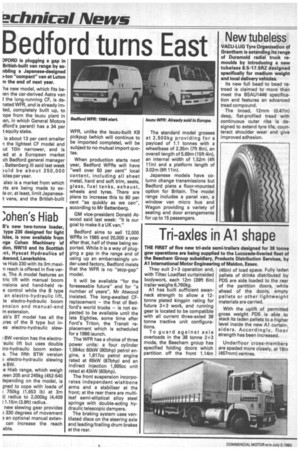Bedford turns East
Page 20

If you've noticed an error in this article please click here to report it so we can fix it.
DFORD is plugging a gap in British-built van range by asnbling a Japanese-designed p-ton "compact" van at Luton rn the end of next year.
he new model, which fits be:en the car-derived Astra van the long-running CF, is deleted WFR, and is already imted, completely built up, to ope from the lsuzu plant in Ian, in which General Motors dford's parent) has a 34 per t equity stake.
is about 13 per cent smaller the lightest CF model and ut 10in narrower, and is ed at a European market ch Bedford general manager . Battenberg Ill said last week )uld be about 250,000 icles per year.
also is a market from which rts are being made to exle or, at least, limit Japaneset vans, and the British-built WFR, unlike the lsuzu-built KB pickpup (which will continue to be imported complete), will be subject to no mutual import quotas.
When production starts next year, Bedford WFRs will have "well over 50 per cent" local content, including all sheet metal, hard and soft trim, seats, glass, fuel tanks, exhaust, wheels and tyres. There are plans to increase this to 80 per cent "as quickly as we can", according to Mr Battenberg.
GM vice-president Donald Atwood said last week: "It is our goal to make it a UK van."
Bedford aims to sell 12,000, WFRs in 1985 and 20,000 a year after that, half of these being exported. While it is a way of plugging a gap in the range and of using up an embarrasingly under-used factory, Bedford insists that the WFR is no "stop-gap" model.
It will be available "for the foreseeable future" and for "a number of years", Mr Atwood insisted. The long-awaited CFreplacement — the first of Bedford's world trucks — is not expected to be available until the late Eighties, some time after Ford's Triton, the Transit replacement which is scheduled for a 1986 launch.
The WFR has a choice of three power units: a four cylinder 1,584cc 60kW (80bhp) petrol engine, a 1,817cc petrol engine rated at 65kW (87bhp) and an indirect injection 1,995cc unit rated at 43kW (60bhp).
The front suspension incorporates independent wishbone arms and a stabiliser at the front; at the rear there are multileaf semi-elliptical alloy steel springs with double-acting hydraulic telescopic dampers.
The braking system uses ventilated discs on the steering axle and leading/trailing drum brakes at the rear. The standard model grosses at 2,50 Okg providing for a payload of 1.1 tonnes with a wheelbase of 2.35m (7ft 8in), an overall length of 5.69m (15ft 4in), an internal width of 1.52m (4ft 11in) and a platform length of 3.02m (9ft 11 in).
Japanese models have column change transmissions but Bedford plans a floor-mounted option for Britain. The model range includes a panel van, a window van micro bus and Wagon providing a variety of seating and door arrangements for up to 15 passengers.




































































































